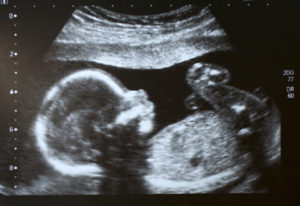CP Caused by Cephalopelvic Disproportion
Due to factors such as genetics or gestational diabetes, a baby’s head (or body) may be too big to safely pass through the mother’s pelvis. This is called cephalopelvic disproportion (CPD).
Cephalopelvic disproportion is a medical condition which can pose life-threatening risks to the child. In the vast majority of cases, cephalopelvic disproportion is identified by medical professionals way before delivery so that doctors are prepared to perform a cesarean section delivery. If CPD is only first suspected during labor, time is of the essence.

Cephalopelvic Disproportion
In almost every case of CPD, doctors are advised to deliver via C-section to reduce the risk of injury to the child.
Cephalopelvic disproportion can occur for a variety of reasons. Some women are born with a narrow pelvis; on the other hand, some babies are naturally large and can have a problem passing through the pelvic opening.
One recent study showed that babies with a head circumference greater than 75th percentile (or less than the 10th percentile) were at five to 10 times higher risk of suffering brain damage during labor and delivery.
Children with CPD who are delivered vaginally may become stuck in the birth canal and suffer from asphyxia, leading to hypoxia and permanent brain damage. They may also be exposed to repeated contractions during delivery, or aggressive clamps and forceps sometimes used to facilitate a problematic delivery.
In addition, medication given to the mother to try and relax her muscles or increase the strength of contractions (i.e., Pitocin) may lead to a decrease in uterine blood flow, resulting in a reduction of oxygen to the child’s brain.
Any serious compression of the child’s skull (especially if stuck for several minutes) may have a detrimental affect on the child’s brain function. Additionally, the child may experience hypoxia (lack of oxygen supply due to circulation being cut off), effectively resulting in permanent brain damage which often leads to the development of neurological problems such as cerebral palsy.
If a doctor fails to perform a cesarean section delivery after cephalopelvic disproportion is identified, this could be considered medical malpractice.
Risk Factors of Cephalopelvic Disproportion
Certain risk factors predispose mothers-to-be to cephalopelvic disproportion. For example: mothers over the age of 35, mothers with a history of gestational diabetes, mothers shorter than 5’3″, those with tailbone congenital deformity, those with a history of pelvic bone tumors, a cervix which doesn’t properly dilate, uterine fibroid tumors, or pelvic bone softening.
Common causes of cephalopelvic disproportion:
- Pelvic Exostoses – A condition marked by bony growths on the pelvis. This is usually hereditary, so patients like these must give birth via C-section to avoid complications.
- Spondylolisthesis – A condition where a spinal bone slips out of its place, causing misalignment all the way down to the pelvis.
- Unusual Presentation – A baby typically comes out of the birth canal head-first, in a fetal position. Should it come out in any other way (e.g., breech position), the pelvis bones of the mother may not separate appropriately to accommodate a smooth delivery.
Warning Signs of Cephalopelvic Disproportion
Here are two common signs which may point to CPD in a pregnancy:
- Excessive Amniotic Fluid – Since the amniotic fluid is mostly made of the baby’s urine, a large amount of amniotic fluid is usually indicative of a larger fetal weight.
- Large Fundal Height – This is the distance between the top of the uterus and the pubic bone. Should your delivery doctor notice a large fundal height, they should consider a C-section delivery.
At the end of the day, it’s the responsibility of medical professionals to look for, identify, and mitigate any preventable issues that could result in serious harm to either the mother or child. Not every birth injury can be blamed on medical malpractice, but if you suspect that your child’s injuries could have been avoided, it’s advised that you speak to a cerebral palsy attorney about the facts of your case and whether or not you have an actionable claim.
